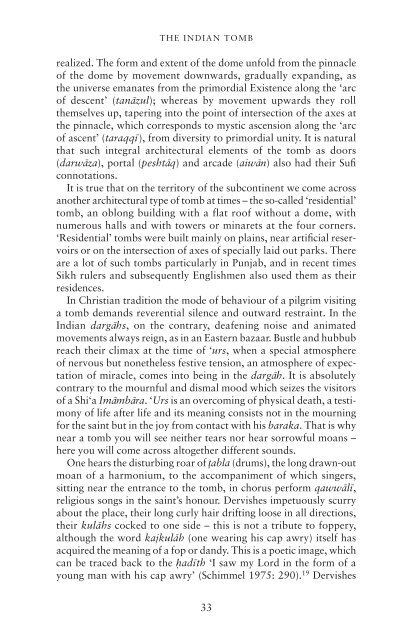Muslim Saints of South Asia: The eleventh to ... - blog blog blog
Muslim Saints of South Asia: The eleventh to ... - blog blog blog
Muslim Saints of South Asia: The eleventh to ... - blog blog blog
Create successful ePaper yourself
Turn your PDF publications into a flip-book with our unique Google optimized e-Paper software.
THE INDIAN TOMB<br />
realized. <strong>The</strong> form and extent <strong>of</strong> the dome unfold from the pinnacle<br />
<strong>of</strong> the dome by movement downwards, gradually expanding, as<br />
the universe emanates from the primordial Existence along the ‘arc<br />
<strong>of</strong> descent’ (tanāzul); whereas by movement upwards they roll<br />
themselves up, tapering in<strong>to</strong> the point <strong>of</strong> intersection <strong>of</strong> the axes at<br />
the pinnacle, which corresponds <strong>to</strong> mystic ascension along the ‘arc<br />
<strong>of</strong> ascent’ (taraqqī), from diversity <strong>to</strong> primordial unity. It is natural<br />
that such integral architectural elements <strong>of</strong> the <strong>to</strong>mb as doors<br />
(darwāza), portal (peshtāq) and arcade (aiwān) also had their Sufi<br />
connotations.<br />
It is true that on the terri<strong>to</strong>ry <strong>of</strong> the subcontinent we come across<br />
another architectural type <strong>of</strong> <strong>to</strong>mb at times – the so-called ‘residential’<br />
<strong>to</strong>mb, an oblong building with a flat ro<strong>of</strong> without a dome, with<br />
numerous halls and with <strong>to</strong>wers or minarets at the four corners.<br />
‘Residential’ <strong>to</strong>mbs were built mainly on plains, near artificial reservoirs<br />
or on the intersection <strong>of</strong> axes <strong>of</strong> specially laid out parks. <strong>The</strong>re<br />
are a lot <strong>of</strong> such <strong>to</strong>mbs particularly in Punjab, and in recent times<br />
Sikh rulers and subsequently Englishmen also used them as their<br />
residences.<br />
In Christian tradition the mode <strong>of</strong> behaviour <strong>of</strong> a pilgrim visiting<br />
a <strong>to</strong>mb demands reverential silence and outward restraint. In the<br />
Indian dargāhs, on the contrary, deafening noise and animated<br />
movements always reign, as in an Eastern bazaar. Bustle and hubbub<br />
reach their climax at the time <strong>of</strong> ‘urs, when a special atmosphere<br />
<strong>of</strong> nervous but nonetheless festive tension, an atmosphere <strong>of</strong> expectation<br />
<strong>of</strong> miracle, comes in<strong>to</strong> being in the dargāh. It is absolutely<br />
contrary <strong>to</strong> the mournful and dismal mood which seizes the visi<strong>to</strong>rs<br />
<strong>of</strong> a Shi‘a Imāmbāra. ‘Urs is an overcoming <strong>of</strong> physical death, a testimony<br />
<strong>of</strong> life after life and its meaning consists not in the mourning<br />
for the saint but in the joy from contact with his baraka. That is why<br />
near a <strong>to</strong>mb you will see neither tears nor hear sorrowful moans –<br />
here you will come across al<strong>to</strong>gether different sounds.<br />
One hears the disturbing roar <strong>of</strong> ţabla (drums), the long drawn-out<br />
moan <strong>of</strong> a harmonium, <strong>to</strong> the accompaniment <strong>of</strong> which singers,<br />
sitting near the entrance <strong>to</strong> the <strong>to</strong>mb, in chorus perform qawwālī,<br />
religious songs in the saint’s honour. Dervishes impetuously scurry<br />
about the place, their long curly hair drifting loose in all directions,<br />
their kulāhs cocked <strong>to</strong> one side – this is not a tribute <strong>to</strong> foppery,<br />
although the word kajkulāh (one wearing his cap awry) itself has<br />
acquired the meaning <strong>of</strong> a fop or dandy. This is a poetic image, which<br />
can be traced back <strong>to</strong> the h˛adīth ‘I saw my Lord in the form <strong>of</strong> a<br />
young man with his cap awry’ (Schimmel 1975: 290). 19 Dervishes<br />
33


